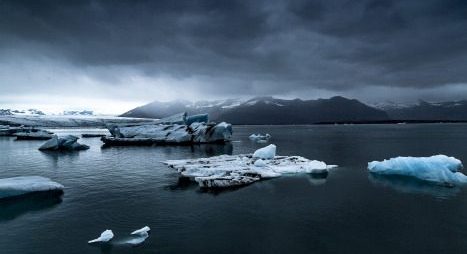In the first two posts on the climate emergency, we covered projections of the impacts of global heating on sea and on land. Obviously the modelling involved in producing these projections is complex and based on a number of assumptions, producing a range of likely outcomes. But the most complex and uncertain areas of the views of the future are – as is the case for most foresight work – the non-linear effects of feedback loops and tipping points. Outcomes can spiral away from the central projection in very unpredictable ways, meaning that we have to consider a much wider range of scenarios for the future.
One of the more well-known climate emergency feedback loops is the “albedo effect”. Albedo – or “whiteness” – is a measure of the reflectivity of a surface. The greater the reflectivity the less of the sun’s heat is absorbed in the planet and its atmosphere. The underlying concern is that as global heating melts the ice caps, exposing the darker ocean surface to sunlight, the water warms up. This melts the ice from underneath, and humidity also increases; water vapour is a powerful greenhouse gas. The seas that become exposed have lower reflectivity, absorbing more heat and accelerating the loss of ice in a vicious circle.
This effect is amplified because the Artic is warming twice as fast as the planet as a whole, and its temperature has already risen by 2°C since pre-industrial levels.
The issue isn’t quite that simple, because as the oceans absorb heat, levels of water vapour increase and more clouds appear. Clouds themselves will reflect heat away from the planet. Deforestation increases albedo because topsoil is more reflective than forests. Burning wood creates black carbon in the atmosphere which if it settles on ice reduces albedo. Algae and other organisms that begin growing on the ice sheet again reduce reflectivity. It’s a complex dynamic mix of trends and forces.
There’s also an effect due to the amount of snow. Ice is darker than snow, and when there is fresh snow, you have a very bright reflective surface – that gives an opportunity for a geo-hack which we’ll discuss in another post.
A related “tipping point” – literally – is the collapse of Greenland and Antarctic ice-sheets. A major collapse would increase sea-levels substantially. If all of the Greenland ice were to melt, global sea levels could be expected to rise by about 25 feet. However, this would take hundreds of years at the current rates of melting. But predicting their behaviour is not straightforward – the Greenland ice-sheet is slipping much faster than expected over what should be unsuitable terrain .
Another feedback loop is melting permafrost releasing methane,one of the most dangerous greenhouse gases. In Northern Siberia last year the ground rose up to form 7,000 large bubbles of methane gasses rising into the empty spaces created by melting permafrost. The pressure is building up inside these bubbles and the gas could be released. The gas contains up to 1,000 times more methane and 25 times more carbon dioxide than the surrounding air. The bursting of these bubbles will release even more gas into the atmosphere, causing more warming and melting permafrost.
Permafrost in the Canadian Arctic is thawing 70 years earlier than predicted. Rapid thawing could release vast quantities of heat-trapping gases, unleashing a feedback loop that would in turn fuel even faster temperature rises. “Thawing permafrost is one of the tipping points for climate breakdown and it’s happening before our very eyes,” said Jennifer Morgan, executive director of Greenpeace International.
As we pointed out last time, there is a massive amount of carbon locked in soils, which hold more carbon than the atmosphere and living vegetation combined. Brazil’s President Bolsanaro has reacted harshly to criticism about deforestation saying “The Amazon belongs to Brazil and European countries can mind their own business because they have already destroyed their own environment”. So the risks here increase exponentially.
Next time we’ll look at how the climate emergency is creating more extreme weather events.
Written by Huw Williams, SAMI Principal
The views expressed are those of the author and not necessarily of SAMI Consulting.
SAMI Consulting was founded in 1989 by Shell and St Andrews University. They have undertaken scenario planning projects for a wide range of UK and international organisations. Their core skill is providing the link between futures research and strategy.
If you enjoyed this blog from SAMI Consulting, the home of scenario planning, please sign up for our monthly newsletter at newreader@samiconsulting.co.uk and/or browse our website at http://www.samiconsulting.co.uk


